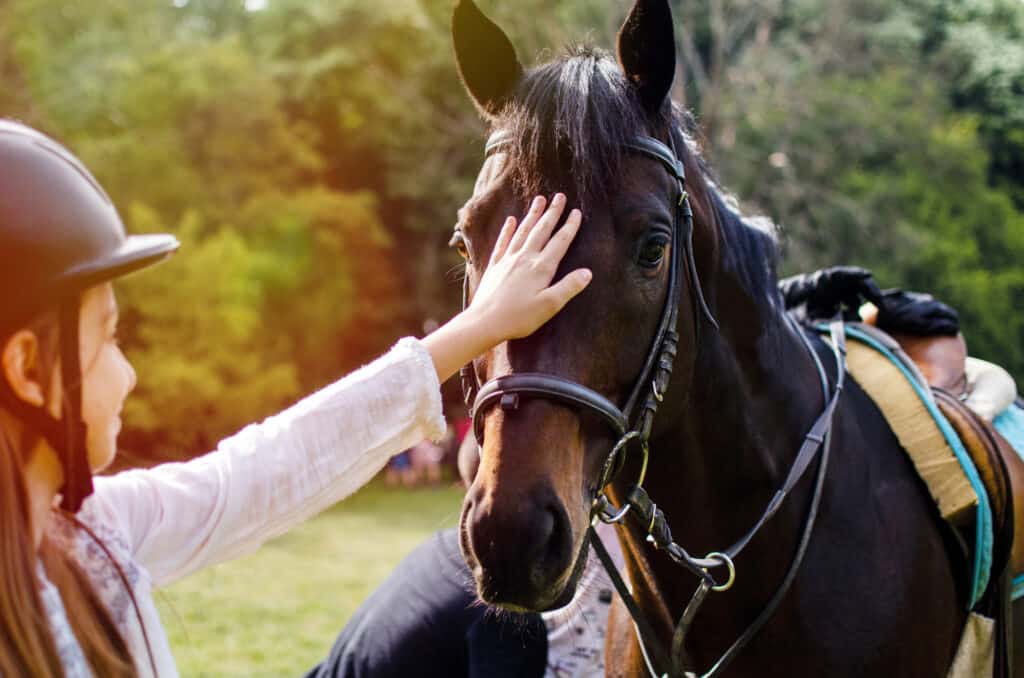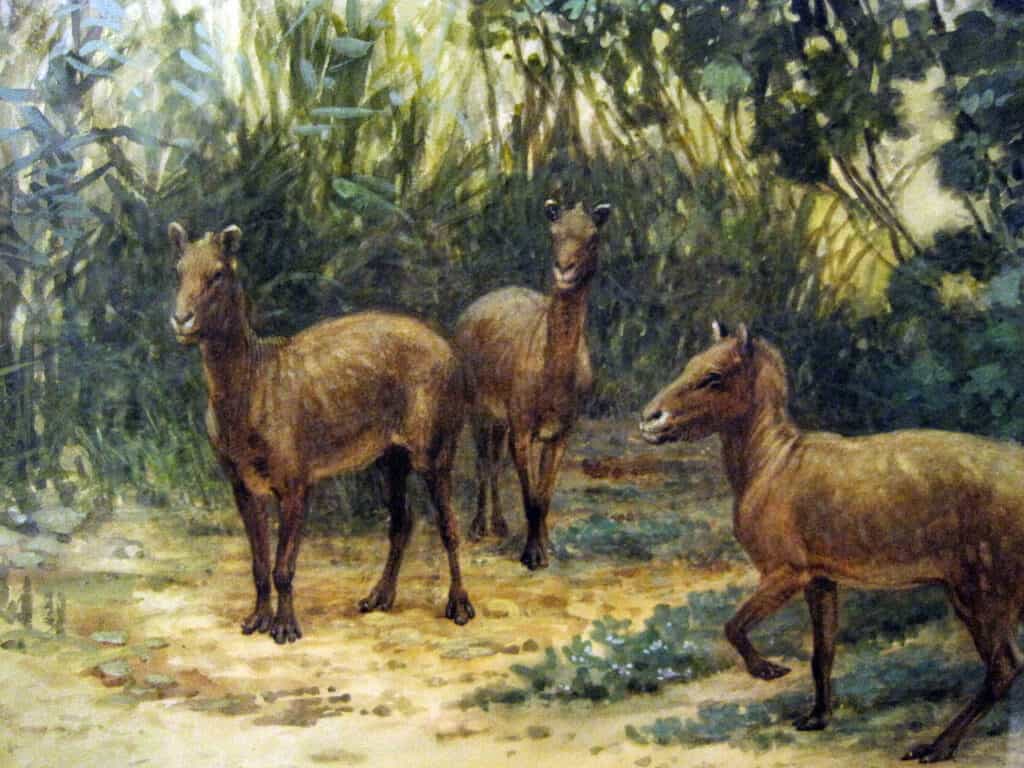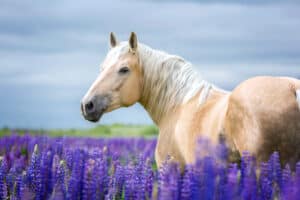Have you ever driven through fields and seen horses grazing? Do you ever wonder what horses you might see if you took that same route thousands of years ago? Today, only two subspecies of horses are alive, but over millions of years, there have been many different types of horses that have since become extinct. This article will introduce four species of extinct horses and close relatives that used to gallop around the wild.
What Are Horses?
Physical Description

There are currently two living subspecies of horses, including the common domestic horse and the Mongolian wild horse.
©iStock.com/Abramova_Kseniya
Modern horses are primarily domesticated, one-toed, hooved mammals that belong to the genus Equus. This genus also includes zebras and donkeys, but they are different species from modern horses – Equus quagga and Equus africanus, respectively. There are currently two living subspecies of horses, including the common domestic horse (Equus ferus caballus) and the Mongolian wild horse (Equus ferus przewalskii). There are, however, hundreds of breeds of horses alive today, all members of the same subspecies, Equus ferus caballus.
Due to artificial breeding and diverse feeding regimens, domestic horses vary greatly in size. Different horses face selective breeding to fulfill specific purposes such as riding, farm work, and cart pulling. Smaller riding horses tend to be 840 to 1,210 pounds. Draft horses, or workhorses, are much larger and weigh between 1,540 to 2,200 pounds. The largest horse on record was a Shire horse named Mammoth, which was 3,360 pounds at its peak weight! The smallest horse ever was a miniature pony affected by dwarfism that weighed only 57 pounds! Shire horses are the largest breed, and the Falabella horse is the smallest breed.
Domestication and Interactions With Humans

The origin of horse domestication is still a hot debate amongst scientists today.
©iStock.com/Biserka Stojanovic
Horses have been incredibly important throughout human history. They have been crucial to human warfare, transportation, agriculture, and other economic and technological pursuits. They also have been central to many recreational activities like jousting, racing (including chariot racing in the Roman Empire), rodeo, polo, dressage, show jumping, hunting for sport, and others.
The origin of horse domestication is still a hot debate amongst scientists today, creating a multidisciplinary argument involving historians, anthropologists, biologists, and more. The most recent theories that predict horse husbandry may date back to the Neolithic period when widespread abandonment of the hunter-gatherer lifestyle led to the development of more permanent agricultural societies. These societies began domesticating animals, including horses, for transportation and manual labor. Multiple theories exist regarding what ancient wild species gave way to the modern domestic species, Equus ferus caballus. This article will discuss some of these now-extinct species!
Wild Horses

The Mongolian wild horse was deemed extinct in the wild but was bred in captivity and reintroduced to its natural habitat in the 1990s.
©Adventure_Images/Shutterstock.com
The only living species of wild horse is the Mongolian wild horse or Przewalski’s horse. This is a rare species that lives mostly in central Asia. The Mongolian wild horse was deemed extinct in the wild but was bred in captivity and reintroduced to its natural habitat in the 1990s. This species’ status has improved immensely, and it is now categorized as endangered by the IUCN and is noted to be increasing in number. They are typically around 600-700 pounds, which is smaller than most domestic horses. Their coats are primarily brown in color, sometimes with faint stripes on their legs, similar to ancient horse species. They have an erect mane, like zebras, that are a darker brown than their primary coat color.
There are several populations of horses in the wild that are what scientists consider feral. This means they are descendants of domestic horses but were born and live in the wild. Populations of feral horses live around the world and are often study subjects of scientists seeking to understand the evolution of behaviors and instincts in domestic horses. These horses are not technically wild because of their lineage and history of domestication.
What Are the IUCN Conservation Status Classifications?

The IUCN evaluates different species and assigns them to categories by a set of criteria that grade a species’ endangerment level.
©Tobias Arhelger/Shutterstock.com
The conservation statuses of various animal and plant species are assessed by the International Union for the Conservation of Nature (the IUCN) and added to their “Red List.” The IUCN evaluates different species and assigns them to one of the following categories on the IUCN Red List: data deficient, least concern, near threatened, vulnerable, endangered, critically endangered, extinct in the wild, and extinct. These categories vary by a set of criteria that grade a species’ endangerment level. Animals and plants at the lowest risk for extinction are “least concern,” and those at high risk are “critically endangered.” The IUCN also tracks if certain populations are trending upwards or downwards in total size. Other organizations that track various endangered species are the U.S. Department of Fish and Wildlife, the World Wildlife Fund, and more. With this background knowledge, let’s meet four extinct horses and horse relatives!
1. Dawn Horse (Eohippus angustidens)

The dawn horse was alive between 55.8 and 47.8 million years ago.
©Charles R. Knight / public domain – License
History and Extinction
The dawn horse (Eohippus angustidens) is the first cool species of extinct horse we will investigate. In fact, it is the oldest species, as well! The dawn horse was alive between 55.8 and 47.8 million years ago. This was during the Eocene Epoch, making it the very first horse species. The defining event marking the end of this epoch was a major extinction event — the Grand Coupure, or the Eocene-Oligocene extinction event. Many ancient ungulate species (large animals with hooves), including some primitive horse species, became extinct; however, the dawn horse was likely extinct before this event.
Description
Eohippus angustidens did not look very similar to modern horse species. This extinct horse species was only about one foot tall and had 4 hooved toes on its front feet and 3 hooved toes on its hind feet. Interestingly, they also had large canine teeth, unlike the canines of horses today. They did, however, have some dental features that are characteristic of modern horses, including traits of the incisors, premolars, and molars. These descriptions are based on numerous fossil specimens that archaeologists have uncovered across North America.
The dawn horse was potentially an omnivore living in North America’s woodland habitats. It was more likely a browser species, feeding on herbaceous woody plants, than a grazer species, which feeds on different grasses. Its hoof size and shape suggest that it had not yet evolved characteristics that were later important to horses running in open plains.
2. The Giant Horse (Equus giganteus)
History and Extinction
The next cool species of an extinct horse is the giant horse, scientifically known as Equus giganteus. The giant horse was alive during the early to mid-Pliocene Epoch to late Pleistocene, approximately between 4.75 million years ago and 12,000 years ago. Its extinction was concurrent with the extinction of other megafauna species in the Americas. Such species include giant sloths, short-faced bears, several large tapirs, the American lion, the saber-toothed cat, mammoths, and others. The reasons for the widespread extinction of megafauna species in the Americas during this time is an ongoing debate. Still, relevant factors likely include extreme changes in the global climate and human forces such as hunting.
Description
Equus giganteus was an ancient megafaunal species. The term megafauna describes extinct or extant large terrestrial animal species. Equus giganteus certainly falls in this category! Current research suggests it weighed between 2,600 and 3,300 pounds and had a shoulder height of 7 feet and five inches. To compare, remember from earlier that the average riding horse today weighs 840-1,210 pounds. Their enormous size makes the giant horse potentially the largest species of horse ever! The giant horse had a mostly tan coat but likely retained faint, stripy, primitive markings on its neck and legs.
3. Tarpan (Equus ferus ferus)

Breeding efforts beginning in the 1930s made attempts to bring back a tarpan-like horse.
©Alborzagros / CC BY-SA 4.0 – License
History and Extinction
Another cool species of an extinct horse is the tarpan. These were free-ranging horses that lived in the Russian steppe from the Early Pleistocene to the Holocene (the current geological epoch). The tarpan likely became completely extinct in 1909 in Russia. Breeding efforts beginning in the 1930s made attempts to bring back a tarpan-like horse. This is a process supporters call “breeding back.” Breeding back, however, does not truly regenerate the extinct wild species; it only creates a modern facsimile horse breed. In this process, multiple modern domestic horse breeds that retain individual tarpan-like traits are bred selectively in an attempt to produce a horse that resembles the tarpan. Today, some of these tarpan-like horses are commercially marketed as tarpans, but again this is a misnomer.
Description
The tarpan had many similarities to modern domestic horses and even belongs to the same species, Equus ferus, although it is a different subspecies. Most tarpans had a grullo coat color, a greyish-tan, mouse-like coloration. They also typically had dark legs. Historical reports of other color combinations, including black coats, lighter legs, or light underbellies, vary geographically and are potentially due to habitat differences. Many retained primitive markings, including stripes on their shoulders, back, and legs. The last living individual was between 55 and 57 inches tall at the shoulder, just under the average shoulder height of modern horses.
4. Quagga (Equus quagga quagga)

Quaggas diverged from other plains zebra subspecies between 120,000 and 290,000 years ago.
©Frederick York (d. 1903) / public domain – License
History and Extinction
The final cool extinct horse species (or at least a close relative) that we will meet is the quagga. Like all horses, zebras, and donkeys, the quagga belongs to the genus Equus. It is an extinct zebra subspecies, not a horse, but that makes it a close relative. Although not technically a horse, the quagga is a very cool animal worth looking at!
Quaggas diverged from other plains zebra subspecies between 120,000 and 290,000 years ago. It was extinct in the wild by 1878, and the final living individual in captivity died in 1883. Scientists speculate that they were once quite prolific throughout Cape Province and the Orange Free State in South Africa. European occupation of South Africa later led to intense hunting pressures that ultimately irradicated the previously flourishing populations of quaggas.
A cool fact about quaggas is that in 1984 they were the first extinct animal to have their DNA analyzed! Since then, many extinct animals have been subjects of genetic analysis, and 20 extinct species have had their entire genomes sequenced. Because DNA degrades over time in different preservation conditions, the oldest DNA of an extinct species to undergo sequencing was 1.65 million years old.
Description
The quagga was an incredibly interesting-looking animal that, in many ways, was similar to modern zebras. Its coat pattern was unique because its head, neck, and shoulders had zebra-like stripes. Its midsection and haunches, however, were more horse-like without stripy patterns. It had an erect mane like modern zebras that also exhibited black and white stripes. The quagga had a shoulder height between 4 feet 1 inch and 4 feet 5 inches. This is just below the average shoulder height of the common zebra, which is between 4 feet and 5 feet 3 inches. The quagga inhabited the most southerly areas of the general geographic distribution of zebra species. Resultantly, they had a thick winter coat that molted every year.
4 of the Oldest Horse Breeds in the World
These 4 extinct horse breeds paved the way for the modern horses we know. There are hundreds of breeds of horses alive that are all members of the same subspecies, Equus ferus caballus.
Here are some of the oldest horse breeds that can be found around the world today:
- Akhal-Teke horses: Formerly called Nisean horses, and known as golden horses because their coat gives off a metallic gold shine in the sun, this breed has been around for at least 3,000 years. There are about 6,600 living in Turkmenistan.
- Norwegian Fjord horses: This large and bulky horse was bred to work. They are agile and good-tempered. Their lineage can be traced to the Vikings who came to Norway around 4,000 years ago and they have been purebred for more than 2,000 years.
- Arabian horses: The most influential horse breed in history, most modern horses currently alive have an Arabian ancestor somewhere in their DNA. Known for their abilities in long endurance races, these lively and fast horses originated with the Bedouin tribe in the Middle East.
- Icelandic horses: Around for more than 1,000 years, these small horses that reach 13-14 hands in height were brought by Viking settlers when they settled in Iceland. Known for their sure-footedness, they were traditionally used for herding sheep, and some still use them this way today.
For 6 more of the oldest horse breeds on Earth go here.

Akhal Teke horses, known as golden horses because of their coat, have been around for at least 3,000 years.
©SunnyMoon/Shutterstock.com
The World’s Oldest Horse
Now we know about the oldest horse breeds, what about the oldest individual horse? The average lifespan of a modern horse is 25-30 years, but this horse lived much longer than that.
The world’s oldest horse on record was Old Billy. True to his name, he reached the impressive age of 62. He was born sometime in 1760 and hailed from Lancashire in England. He worked as a barge horse and became a local celebrity over time as he grew older. After he died, his skull was displayed at Manchester Museum and his taxidermied skin was given to Cecil Higgins Art Gallery & Bedford Museum.
Another horse that lived much longer than normal was Sugar Puff, also from the U.K., who was born in 1951 and reached 56 years of age.
Summary of 4 Extinct Horse Species
| Number | Extinct Horse | Description |
|---|---|---|
| 1 | Dawn Horse | One foot tall with 4 hooved toes on its front feet and 3 hooved toes on its hind feet, large canine teeth |
| 2 | The Giant Horse | Weighed between 2,600 and 3,300 pounds with a shoulder height of 7 feet and five inches, tan coat with markings |
| 3 | Tarpan | A grullo coat color – a greyish-tan, mouse-like coloration with dark legs |
| 4 | Quagga | Looked like a zebra with stripes from the neck up – solid color from the neck down |
The photo featured at the top of this post is © arthorse/Shutterstock.com
Thank you for reading! Have some feedback for us? Contact the AZ Animals editorial team.






